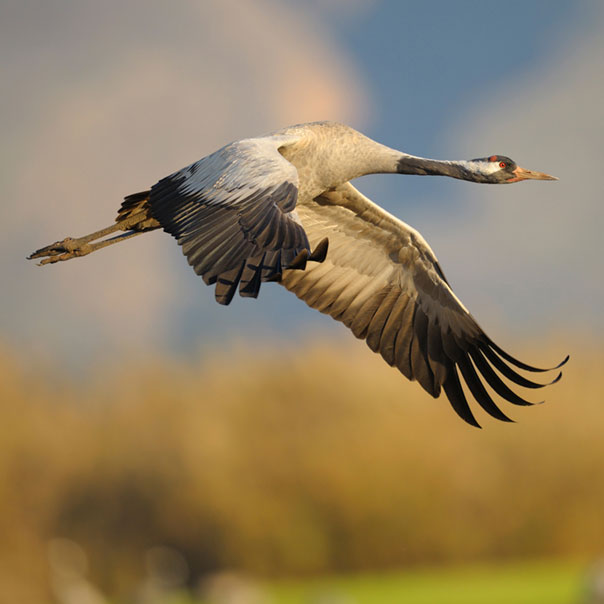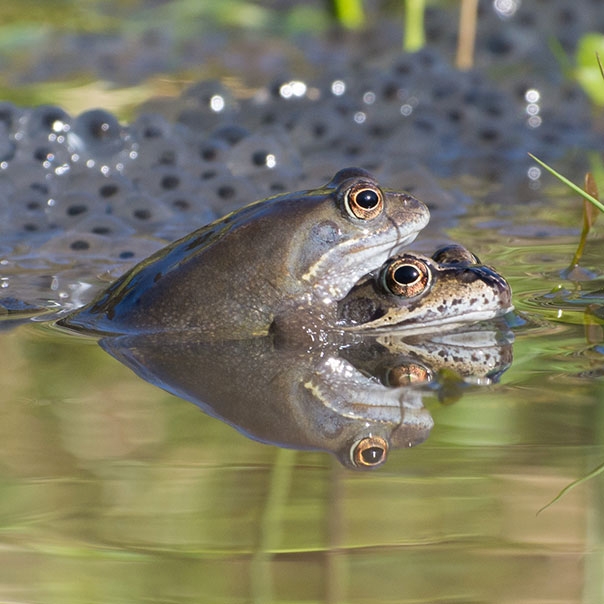Herons and egrets found in UK wetlands
You can find these long-necked, pointy-beaked birds wading through the shallows of UK wetlands. Some you’ll be familiar with whilst some can be tricky to spot and others have only made an appearance recently, influenced by our warming climate.
Whilst not in the wader family, the herons, egrets, ibis, cranes and storks do behave in a similar fashion, using their long bills to catch and eat their prey.
Where do these birds live?
Commoner species like the grey heron can be found on almost any body of water, from a city garden, to a river, to a brackish tidal creek. Some of the below species are found in more specialised habitats but all will be seen with water somewhere nearby.

What do these birds eat?
This is a group of opportunists and they will eat anything that fits in their powerful bill – insects, fish, amphibians, small mammals and even other small birds, such as ducklings.

A guide to UK herons and egrets
Grey heron
Ardea cinerea
Widespread across the UK, they are easily recognisable with a large yellow bill, pale neck, grey body and long black plumes from eyebrow to neck. In flight, like all UK herons and egrets, the neck is retracted.

Bittern
Botaurus stellaris
A stocky, brown-streaked bird – very well adapted to camouflage in its reedbed habitat, from which the males can be heard ‘booming’ in the spring to attract a mate – a very deep, low two-note song that seems to come from all directions. In the late 1990’s, booming males were only just into double figures, but with expansion of their reedbed habitat, they’re now at over 200 by the last count (BTO). In flight, they appear broad-winged and chunky, however if you’re lucky enough to spot one on the ground, they may adopt a frozen posture where they point their bill up to the sky, camouflaging themselves in the surrounding reeds.

Little egret
Egretta garzetta
A slim and elegant egret, with black bill and long white head-plumes. If you see them on dry land, their legs are long and black whilst their feet are bright yellow. One of the early colonists taking advantage of a warming UK climate, they first bred here in 1996 (BTO) but prior to that it was rare to see them here. They’re now an almost guaranteed bird when birdwatching in a UK wetland, but still more so in the south.

Great egret
Ardea alba
Similar in plumage to little egret but almost as large as grey heron, great egrets are all white with a large, yellow bill. In flight, their all-black legs project long past the tail. Once considered a rare vagrant from Europe, they started breeding in UK wetlands in 2012 and while still rarer than little egrets, great egrets can now be seen in many areas, most commonly in winter (BTO).

Cattle egret
Bubulcus ibis
A small, compact egret and the smallest member of this family, they have a short, yellow bill and yellowish legs. In the breeding season, patches of plumage turn a rusty orange. As their name suggests, they can be found amongst livestock and often feed away from water. Once a rarity in the UK, they have been breeding continuously here since 2017 (BTO).

Spoonbill
Platalea leucorodia
An unmistakeable bird; it’s easy to see why they are so-named. The adults have black legs and a black bill with a broad yellow tip, whereas the juveniles have pink legs and a pinkish bill. Spoonbills, unlike herons and egrets, fly with their neck outstretched. Once a scarce migrant, they’ve now been breeding in the UK since 2010, with pairs numbering around 30 (BTO).

Glossy ibis
Plegadis falcinellus
Almost looking like a dark-plumaged curlew, these birds are hard to mistake for anything else. More often seen in the UK during winter, records are increasing, like many of the above heron species. There have been a few breeding attempts but this is not yet regular; it’s likely that soon could change as average temperatures continue to climb.

Common crane
Grus grus
These very tall birds are making a comeback to UK wetlands; previously extinct for 400 years, they’ve steadily been naturally colonising as well as benefitting from reintroduction projects. They could be confused with grey heron but are taller, with a red crown and solid black face and neck. Listen for their excited, bugling call and watch for their huge flight shape with neck outstretched.

White stork
Ciconia ciconia
Another very tall bird, storks are currently being introduced to various UK locations after a 600 year absence but migrants from the continent also occur. They’re distinctively coloured with black and white feathers, red legs and a long, red bill. Like the crane, they hold their neck stretched outwards in flight.

What might the future hold?
Dalmation pelican
Pelecanus crispus
Enormous white birds, known for scooping up fish with their bright-orange bill-pouch. Seen in the fossil and archaeological records to have bred in UK wetlands up to Roman times, they were forced out due to a loss of wetland habitat. They’re a potential candidate for future reintroduction, with our forecast milder winters making conditions particularly suitable.

Like some of the above forerunners, we are seeing more species from this family appear in UK wetlands, with ranges expanding northwards from the Mediterranean, due to climate change. All of the below occur in the UK annually and are potentially future breeders.
Purple heron
Ardea purpurea
Similar in looks to grey heron but slightly slimmer in structure and with a longer, narrower bill that is often held pointing upwards, they have occasionally bred in the UK but are more commonly found across much of southern and western Europe, as well as across Africa and southern Asia as far as Indonesia. Plumage-wise, they feature red and black stripes along the neck whilst the rest of the feathers are a mix of dark grey, brown and purple depending on the light. As with other herons and egrets, they hold their neck in when flying.

Little bittern
Ixobrychus minutus
A surprisingly tiny bird – smaller than a moorhen! The adult male is cream-coloured with a black cap, back and tail, whereas the female is similar but browner in colour and plumage more streaked, providing camouflage in their reedbed habitat. They have bred in the UK a handful of times but are more commonly found across much of Europe, Africa and central Asia.

Night heron
Nycticorax nycticorax
As the name suggests, this small heron is active mainly at night but can be observed during daylight hours too. Grey in plumage with yellow legs, a black bill, cap and back. There are already a handful of breeding records in the UK, with the species being widespread across Europe, Asia and Africa, as well as occurring across the Americas. An adaptable heron!

Squacco heron
Ardeola ralloides
This small heron appears mostly cream with brown streaks, with long nape feathers when viewed on the ground. However, pure white wings and tail immediately become apparent in flight. Not known to have yet bred in the UK, they can be found across southern Europe, the Middle East and Africa.

Threats to these species and how WWT are helping
Today, these large birds are still affected by lack of habitat and other modern infrastructure such as power lines, known to be a collision risk for storks in particular.
For hundreds of years, UK wetlands have been drained for agriculture, resulting in a loss of habitat for many of our species. As well as historic hunting, this is the key reason that species such as common crane and white stork went extinct in the UK – we're working to restore wetlands on a national scale and you can help with our campaign for 100,000 hectares of new wetlands.
We are also introducing those species that need help to re-establish. In 2010, the WWT conservation breeding team raised nearly 100 young cranes at Slimbridge, which were released on the Somerset Levels to boost the wild population.
Species reintroductions like these are a catalyst for creating new wetlands via engagement with local people, and WWT seek to restore wetlands on a national scale. Ultimately, this group of birds can settle into a wide variety of environments and aren’t that fussy on what they eat – provided with suitable habitat, they will thrive.
If you're keen to spot herons and egrets, WWT wetlands sites are a great place to start.
Find your nearest WWT site

